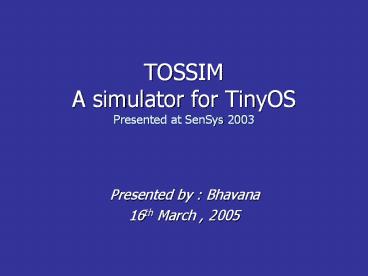TOSSIM A simulator for TinyOS Presented at SenSys 2003 - PowerPoint PPT Presentation
Title:
TOSSIM A simulator for TinyOS Presented at SenSys 2003
Description:
Compiles directly from TinyOS source. Simulates network at bit level ... Compile application code to TOSSIM or hardware platform as needed ... – PowerPoint PPT presentation
Number of Views:324
Avg rating:3.0/5.0
Title: TOSSIM A simulator for TinyOS Presented at SenSys 2003
1
TOSSIMA simulator for TinyOSPresented at SenSys
2003
- Presented by Bhavana
- 16th March , 2005
2
Why Simulation for Sensor Networks?
- Sensor networks are new, event-driven, large,
deployed in remote locations - Simulation provides
- Controlled , Reproducible testing environment
- Cost effective alternative
- Means to explore and improve design space
3
Existing Simulation Tools
- ns-2
- Packet Level network abstraction
- Does not model application behavior (not complete
and inappropriate for sensor networks)
Others SensorSim, EmStar, TOSSF,
Proteus, Emstar
4
TOSSIM The Simulator
- TinyOS mote simulator
- Scales to thousands of nodes
- Compiles directly from TinyOS source
- Simulates network at bit level
- Replaces hardware with software components
- Hardware interrupts are modeled as simulator
events.
5
(No Transcript)
6
Goals of TOSSIM
- Scalability able to handle large
- networks
- Completeness capture complete system
- behavior
- Fidelity Capture behavior at a
- fine-grain
- Bridging the gap between
- algorithms and
implementation
7
Bridging
- make sim instead of make mica
- Instrumented nesC compiler
- Compile application code to TOSSIM or hardware
platform as needed - No change to application required
- Tested code can be deployed right away
8
Scalability
- Individual mote resources very small
- Static component memory model simplifies state
management .
9
Fidelity
- Emulating hardware at component level
- Bit-level simulation capturing network at high
fidelity - TOSSIM helped in debugging some TinyOS network
stack problems - These problems were unnoticed during testbed
deployment
10
Simulation Time
- Time at mote instruction cycle frequency
- 4 MHz 4 x 106 ticks/second
- e.g. 400 ticks between 10Kb radio interrupts
- Chosen as minimum value that allows accurate
radio and system clock modeling
11
Radio Models
- Radio models external to TOSSIM
- Models network as a directed graph of bit error
probabilities. - Built-in models Simple, Static, Space
12
Communication Services
- Allows user to drive, monitor, debug simulation
- Command/event interface
- Eg. TinyViz
13
Network Simulation
- Most complex and fine grained component of TOSSIM
- Almost perfect simulation of TinyOS networking
stack at bit level - Combination of bit sampling and bit rate changes
used for capturing the entire stack.
14
Evaluation
- Scalability
- - CntToLeds
- - RfmToLeds
- - CntToRfm
- Fidelity
- - radio noise
- - packet interactions
- - subtle race conditions
- Completeness
- Surge
- TinyDB
15
Analysis of Surge
16
Scalability
17
Possible Enhancements
- CPU modeling run-instantly model
- Energy modeling
- Supporting thread based execution models
- Supporting heterogeneous platforms
- Allowing Different mote applications to run at
once
18
Summary
- TOSSIM simulates TinyOS applications for sensor
networks - The same code can be used both for simulation and
testbed deployment - It is scalable and extensible
- Does not address energy profiling
- Applicable only in TinyOS platform
19
References
- www.tinyos.net
- UC Berkeley TOSSIM website www.cs.berkeley.edu/
pal/research/tossim.html - EmTOS http//lecs.cs.ucla.edu/thanos/cs113EmTOS
.ppt - http//webs.cs.berkeley.edu/weekly/simulator.ppt
20
Questions ?































